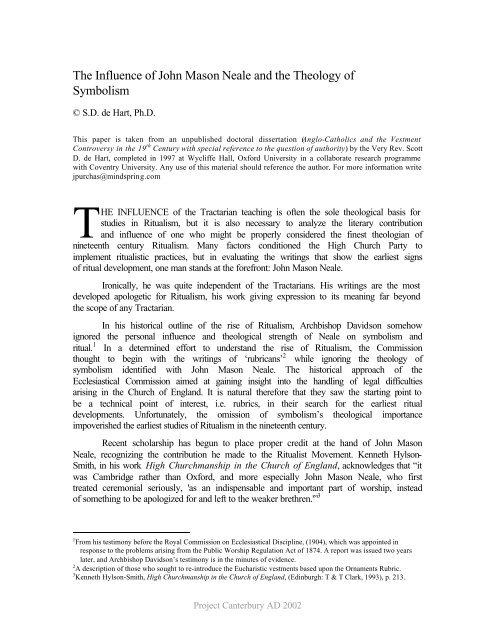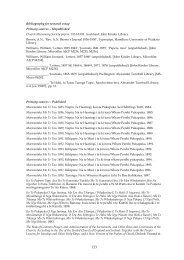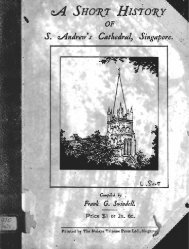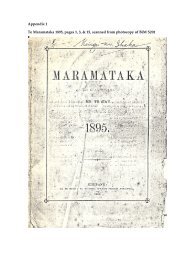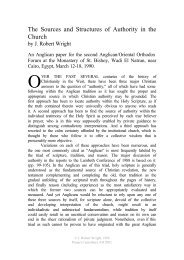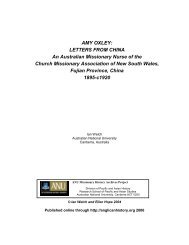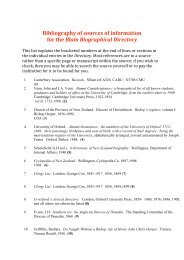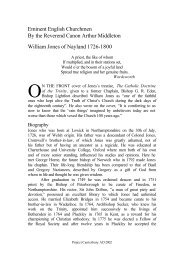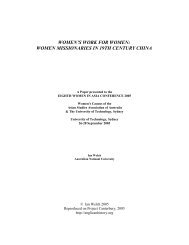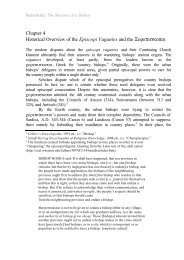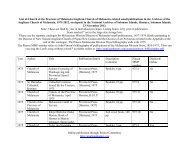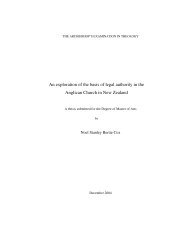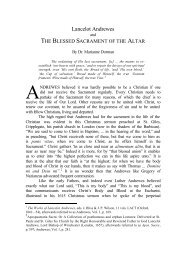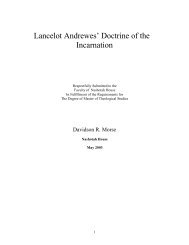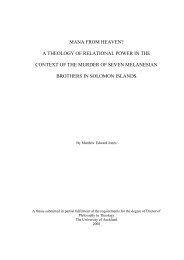The Influence of John Mason Neale and the - Project Canterbury
The Influence of John Mason Neale and the - Project Canterbury
The Influence of John Mason Neale and the - Project Canterbury
You also want an ePaper? Increase the reach of your titles
YUMPU automatically turns print PDFs into web optimized ePapers that Google loves.
<strong>The</strong> <strong>Influence</strong> <strong>of</strong> <strong>John</strong> <strong>Mason</strong> <strong>Neale</strong> <strong>and</strong> <strong>the</strong> <strong>The</strong>ology <strong>of</strong><br />
Symbolism<br />
© S.D. de Hart, Ph.D.<br />
This paper is taken from an unpublished doctoral dissertation (Anglo-Catholics <strong>and</strong> <strong>the</strong> Vestment<br />
Controversy in <strong>the</strong> 19 th Century with special reference to <strong>the</strong> question <strong>of</strong> authority) by <strong>the</strong> Very Rev. Scott<br />
D. de Hart, completed in 1997 at Wycliffe Hall, Oxford University in a collaborate research programme<br />
with Coventry University. Any use <strong>of</strong> this material should reference <strong>the</strong> author. For more information write<br />
jpurchas@mindspring.com<br />
T<br />
HE INFLUENCE <strong>of</strong> <strong>the</strong> Tractarian teaching is <strong>of</strong>ten <strong>the</strong> sole <strong>the</strong>ological basis for<br />
studies in Ritualism, but it is also necessary to analyze <strong>the</strong> literary contribution<br />
<strong>and</strong> influence <strong>of</strong> one who might be properly considered <strong>the</strong> finest <strong>the</strong>ologian <strong>of</strong><br />
nineteenth century Ritualism. Many factors conditioned <strong>the</strong> High Church Party to<br />
implement ritualistic practices, but in evaluating <strong>the</strong> writings that show <strong>the</strong> earliest signs<br />
<strong>of</strong> ritual development, one man st<strong>and</strong>s at <strong>the</strong> forefront: <strong>John</strong> <strong>Mason</strong> <strong>Neale</strong>.<br />
Ironically, he was quite independent <strong>of</strong> <strong>the</strong> Tractarians. His writings are <strong>the</strong> most<br />
developed apologetic for Ritualism, his work giving expression to its meaning far beyond<br />
<strong>the</strong> scope <strong>of</strong> any Tractarian.<br />
In his historical outline <strong>of</strong> <strong>the</strong> rise <strong>of</strong> Ritualism, Archbishop Davidson somehow<br />
ignored <strong>the</strong> personal influence <strong>and</strong> <strong>the</strong>ological strength <strong>of</strong> <strong>Neale</strong> on symbolism <strong>and</strong><br />
ritual. 1 In a determined effort to underst<strong>and</strong> <strong>the</strong> rise <strong>of</strong> Ritualism, <strong>the</strong> Commission<br />
thought to begin with <strong>the</strong> writings <strong>of</strong> ‘rubricans’ 2 while ignoring <strong>the</strong> <strong>the</strong>ology <strong>of</strong><br />
symbolism identified with <strong>John</strong> <strong>Mason</strong> <strong>Neale</strong>. <strong>The</strong> historical approach <strong>of</strong> <strong>the</strong><br />
Ecclesiastical Commission aimed at gaining insight into <strong>the</strong> h<strong>and</strong>ling <strong>of</strong> legal difficulties<br />
arising in <strong>the</strong> Church <strong>of</strong> Engl<strong>and</strong>. It is natural <strong>the</strong>refore that <strong>the</strong>y saw <strong>the</strong> starting point to<br />
be a technical point <strong>of</strong> interest, i.e. rubrics, in <strong>the</strong>ir search for <strong>the</strong> earliest ritual<br />
developments. Unfortunately, <strong>the</strong> omission <strong>of</strong> symbolism’s <strong>the</strong>ological importance<br />
impoverished <strong>the</strong> earliest studies <strong>of</strong> Ritualism in <strong>the</strong> nineteenth century.<br />
Recent scholarship has begun to place proper credit at <strong>the</strong> h<strong>and</strong> <strong>of</strong> <strong>John</strong> <strong>Mason</strong><br />
<strong>Neale</strong>, recognizing <strong>the</strong> contribution he made to <strong>the</strong> Ritualist Movement. Kenneth Hylson-<br />
Smith, in his work High Churchmanship in <strong>the</strong> Church <strong>of</strong> Engl<strong>and</strong>, acknowledges that “it<br />
was Cambridge ra<strong>the</strong>r than Oxford, <strong>and</strong> more especially <strong>John</strong> <strong>Mason</strong> <strong>Neale</strong>, who first<br />
treated ceremonial seriously, 'as an indispensable <strong>and</strong> important part <strong>of</strong> worship, instead<br />
<strong>of</strong> something to be apologized for <strong>and</strong> left to <strong>the</strong> weaker brethren.'” 3<br />
1 From his testimony before <strong>the</strong> Royal Commission on Ecclesiastical Discipline, (1904), which was appointed in<br />
response to <strong>the</strong> problems arising from <strong>the</strong> Public Worship Regulation Act <strong>of</strong> 1874. A report was issued two years<br />
later, <strong>and</strong> Archbishop Davidson’s testimony is in <strong>the</strong> minutes <strong>of</strong> evidence.<br />
2 A description <strong>of</strong> those who sought to re-introduce <strong>the</strong> Eucharistic vestments based upon <strong>the</strong> Ornaments Rubric.<br />
3 Kenneth Hylson-Smith, High Churchmanship in <strong>the</strong> Church <strong>of</strong> Engl<strong>and</strong>, (Edinburgh: T & T Clark, 1993), p. 213.<br />
<strong>Project</strong> <strong>Canterbury</strong> AD 2002
<strong>The</strong> <strong>Influence</strong> <strong>of</strong> J.M. <strong>Neale</strong> <strong>and</strong> <strong>the</strong> <strong>The</strong>ology <strong>of</strong> Symbolism, by S.D. de Hart<br />
<strong>Neale</strong>’s independence <strong>of</strong> <strong>the</strong> Tractarians was not out <strong>of</strong> disapproval <strong>of</strong> <strong>the</strong> teaching,<br />
though he admittedly was frustrated with <strong>the</strong> doctrines that lacked outward expression. In<br />
writing to Benjamin Webb, 1844, <strong>Neale</strong> remarks:<br />
I hope <strong>and</strong> trust you are not going to Oxonianize. It is clear to me that <strong>the</strong><br />
Tract writers missed one great principle, namely that <strong>of</strong> Aes<strong>the</strong>tics, <strong>and</strong> it is<br />
unworthy <strong>of</strong> <strong>the</strong>m to blind <strong>the</strong>mselves to it. 4<br />
Attempting to go beyond <strong>the</strong> Tractarians did not mean that his thoughts differed<br />
greatly from <strong>the</strong>irs. It is evident that <strong>Neale</strong>’s attempt to relate <strong>the</strong> physical to <strong>the</strong> unseen<br />
world <strong>of</strong> spirit as a means <strong>of</strong> communicating <strong>the</strong> grace <strong>of</strong> God was one <strong>of</strong> <strong>the</strong> foremost<br />
doctrines <strong>of</strong> Pusey <strong>and</strong> <strong>the</strong> Oxford Movement. 5<br />
<strong>The</strong> importantce <strong>and</strong> energy <strong>of</strong> <strong>Neale</strong>’s work became most evident with <strong>the</strong><br />
Cambridge Camden Society, founded in 1839 by <strong>Neale</strong>, E.J. Boyce, <strong>and</strong> Benjamin Webb.<br />
It was named after William Camden, <strong>the</strong> antiquary, who died in 1623. <strong>The</strong> object <strong>of</strong> <strong>the</strong><br />
Society was ‘to perpetuate <strong>and</strong> render accessible whatever is valuable, but at present little<br />
known, amongst <strong>the</strong> materials for <strong>the</strong> civil, ecclesiastical or literary hi <strong>of</strong> <strong>the</strong> United<br />
Kingdom.’ 6 Beginning in 1841, <strong>the</strong> Society published a magazine called <strong>The</strong><br />
Ecclesiologist. In 1846 <strong>the</strong> Cambridge Camden Society changed <strong>the</strong>ir name to <strong>the</strong><br />
Ecclesiological Society, <strong>and</strong> its determined aim was now concerned with ‘<strong>the</strong> science <strong>of</strong><br />
symbolism; <strong>the</strong> principle <strong>of</strong> church arrangements; church music <strong>and</strong> all <strong>the</strong> decorative<br />
arts, which can be m subservient to religion.’ 7<br />
In <strong>the</strong> formative stages <strong>of</strong> <strong>the</strong> Ecclesiological Society, <strong>Neale</strong> had interest in <strong>the</strong><br />
question <strong>of</strong> Eucharistic Vestments <strong>and</strong> purposed that his work would lead to a reintroduction<br />
<strong>of</strong> <strong>the</strong> vestment in Church <strong>of</strong> Engl<strong>and</strong> services. In <strong>the</strong> preface to <strong>the</strong><br />
Hierurgia Anglicana, a product <strong>of</strong> <strong>the</strong> Ecclesiological Society, we get a glimpse <strong>of</strong><br />
<strong>Neale</strong>’s ambitions for <strong>the</strong> Society; “In reference to <strong>the</strong> Eucharistic Vestments in<br />
particular, we are surprised that <strong>the</strong> ecclesiological movement <strong>of</strong> <strong>the</strong> last ten years has<br />
accomplished little or nothing towards <strong>the</strong>ir restoration.” 8 This reference to <strong>the</strong> vestments<br />
<strong>and</strong> <strong>the</strong> desire for <strong>the</strong>ir restoration complements <strong>the</strong> idea running through <strong>Neale</strong>’s o<strong>the</strong>r<br />
early writings. 9<br />
It was during his years as a Cambridge University student that <strong>John</strong> <strong>Mason</strong> <strong>Neale</strong><br />
made an initial study <strong>of</strong> church architecture. <strong>The</strong> result <strong>of</strong> this study led <strong>Neale</strong> to <strong>the</strong><br />
principles that remain <strong>the</strong> most comprehensive analysis <strong>of</strong> what <strong>the</strong> <strong>the</strong>ology <strong>of</strong><br />
symbolism is. In 1843, <strong>John</strong> <strong>Mason</strong> <strong>Neale</strong> <strong>and</strong> Benjamin Webb translated <strong>and</strong> included<br />
4 A.G. Lough, <strong>John</strong> <strong>Mason</strong> <strong>Neale</strong>. Priest Extraordinary, (Devon: A.G. Lough, 1975), p. 55.<br />
5 cf. Ge<strong>of</strong>frey Rowell, <strong>The</strong> Vision Glorious, (Oxford: Oxford University Press, 1983), p. 100.<br />
6 A.G. Lough, <strong>John</strong> <strong>Mason</strong> <strong>Neale</strong>. Priest Extraordinary, p. 16.<br />
7 Kenneth Hylson-Smith, High Churchmanship in <strong>the</strong> Church <strong>of</strong> Engl<strong>and</strong>, (Edinburgh: T & T Clark, 1993), p. 213.<br />
8 Ecclesiological Society, Hierurgia Anglicana, (London: Rivington, 1848), p. ix.<br />
9 As early as 1843, <strong>Neale</strong> remarked ‘I am sure that when once churches are built or restored to be equal to those <strong>of</strong> olden<br />
times,...<strong>the</strong> poverty <strong>of</strong> our present vestments will become intolerable.’ Hierologus, p. 71. He also wrote to Benjamin<br />
Webb in 1846, “<strong>The</strong> great use <strong>of</strong> <strong>the</strong> cope is, it strikes me, to accustom our people to coloured vestments; once do<br />
that <strong>and</strong> do it on such irrefragable Anglican grounds as we have, <strong>and</strong> <strong>the</strong> Chasuble follows without difficulty.”<br />
Letters, p. 94.<br />
[2]
<strong>The</strong> <strong>Influence</strong> <strong>of</strong> J.M. <strong>Neale</strong> <strong>and</strong> <strong>the</strong> <strong>The</strong>ology <strong>of</strong> Symbolism, by S.D. de Hart<br />
an introductory essay on <strong>The</strong> Symbolism <strong>of</strong> Churches <strong>and</strong> Church Ornaments, by Bishop<br />
Dur<strong>and</strong>us. <strong>The</strong> introductory essay unveils a clear apologetic for Ritualism <strong>and</strong> symbolism<br />
in Divine worship. <strong>The</strong> purpose <strong>of</strong> <strong>the</strong> translation in 1843, a remarkably early date in <strong>the</strong><br />
chronology <strong>of</strong> ritual advances, is stated thus:<br />
<strong>The</strong> interest which has lately been displayed, as on all subjects connected with<br />
Ecclesiology, so more especially on <strong>the</strong> symbolical bearing <strong>of</strong> Church<br />
Architecture, has led us to imagine, that a translation <strong>of</strong> <strong>the</strong> most valuable<br />
work on symbolism which <strong>the</strong> Middle Ages can furnish, might not, at <strong>the</strong><br />
present time, be unacceptable to Churchmen...We have considered it<br />
necessary to prefix an Essay on that subject; in which we have endeavoured to<br />
prove that Catholick Architecture must necessarily be symbolical. 10<br />
James White, author <strong>of</strong> <strong>The</strong> Cambridge Movement, writes that <strong>the</strong> Introductory Essay<br />
is <strong>of</strong> great significance because it is “<strong>the</strong> first statement <strong>of</strong> many ideas which came to be<br />
<strong>the</strong> dogmas <strong>of</strong> ecclesiology.” 11<br />
In this essay, a st<strong>and</strong>ard for proper church architecture is described, but <strong>the</strong> principle<br />
for symbolism in all areas <strong>of</strong> worship is developed. <strong>The</strong> importance <strong>of</strong> symbolic design<br />
<strong>and</strong> godly inspiration in architecture was not to be underestimated. <strong>The</strong> time best<br />
reflecting all <strong>of</strong> <strong>the</strong> st<strong>and</strong>ards <strong>Neale</strong> identifies for perfection in church architecture <strong>and</strong> its<br />
accompanying symbolism was <strong>the</strong> Medieval period. <strong>The</strong> Gothic architecture <strong>Neale</strong><br />
identified as <strong>the</strong> paragon <strong>of</strong> Christian symbolism was to be viewed as much more than an<br />
aes<strong>the</strong>tically pleasing example. For <strong>Neale</strong>, it was nothing short <strong>of</strong> <strong>the</strong> Divine illustration<br />
<strong>of</strong> catholic teaching. Through <strong>the</strong> surpassing beauty <strong>of</strong> Gothic architecture God was<br />
vividly displaying a liturgical <strong>and</strong> <strong>the</strong>ological principle. 12 <strong>The</strong> unrivaled symbolic beauty<br />
<strong>of</strong> <strong>the</strong> Medieval Church was providentially intended as a timeless principle illustrating<br />
how sacramental signs <strong>and</strong> instruments convey <strong>the</strong> grace <strong>of</strong> God.<br />
<strong>The</strong> higher principle behind symbolism <strong>Neale</strong> described as Sacramentality. 13<br />
Symbolism <strong>and</strong> ritual were established according to <strong>the</strong> providence <strong>of</strong> God for <strong>the</strong><br />
purpose <strong>of</strong> elevating ordinary objects or human actions beyond <strong>the</strong>ir common use <strong>and</strong><br />
<strong>the</strong>reby enabling <strong>the</strong>m to serve a higher purpose. <strong>The</strong> Old Testament idea <strong>of</strong><br />
consecration, an action which takes <strong>the</strong> pr<strong>of</strong>ane <strong>and</strong> elevates it to a new <strong>and</strong> higher<br />
design, is closely tied to <strong>Neale</strong>’s definition <strong>of</strong> Sacramentality. “Symbolism is thus <strong>the</strong><br />
true sign <strong>of</strong> <strong>the</strong> cross, hallowing <strong>the</strong> unholy, <strong>and</strong> making safe <strong>the</strong> dangerous.” 14<br />
In <strong>the</strong> introductory essay to <strong>the</strong> translation <strong>of</strong> Dur<strong>and</strong>us, <strong>Neale</strong> outlines <strong>the</strong> principle<br />
arguments for <strong>the</strong> use <strong>of</strong> symbols <strong>and</strong> ritual in Divine Worship. <strong>The</strong> first argument given<br />
10 <strong>John</strong> <strong>Mason</strong> <strong>Neale</strong>, Benjamin Webb, translators, <strong>The</strong> Symbolism <strong>of</strong> Churches <strong>and</strong> Church Ornaments by William<br />
Dur<strong>and</strong>us. A Translation by <strong>John</strong> <strong>Mason</strong> <strong>Neale</strong> <strong>and</strong> Benjamin Webb, with an Introductory Essay. (Leeds: T.W.<br />
Green, 1843), p. vii.<br />
11 James White, <strong>The</strong> Cambridge Movement, (Cambridge: Cambridge University Press, 1979), p. 70.<br />
12 Ge<strong>of</strong>frey Rowell, <strong>The</strong> Vision Glorious, (Oxford: Oxford University Press, 1983), p. 101.<br />
13 Defined by <strong>Neale</strong> as ‘by <strong>the</strong> outward <strong>and</strong> visible form, is signified something inward <strong>and</strong> spiritual: that <strong>the</strong> material<br />
fabrick symbolizes, embodies, figures, represents, expresses, answers to, some abstract meaning.’<br />
14 J.M. <strong>Neale</strong>, Dur<strong>and</strong>us. p. xliv.<br />
[3]
<strong>The</strong> <strong>Influence</strong> <strong>of</strong> J.M. <strong>Neale</strong> <strong>and</strong> <strong>the</strong> <strong>The</strong>ology <strong>of</strong> Symbolism, by S.D. de Hart<br />
by <strong>Neale</strong> employs an a priori method <strong>of</strong> establishing <strong>the</strong> early Church as a reliable guide<br />
in <strong>the</strong> use <strong>of</strong> symbolism. <strong>Neale</strong> asserts:<br />
Indeed, almost every great doctrine had been symbolized at a very early<br />
period <strong>of</strong> Christianity. <strong>The</strong> resurrection was set forth in <strong>the</strong> Phoenix, rising<br />
immortal from its ashes: <strong>the</strong> meritorious Passion <strong>of</strong> our Saviour, by <strong>the</strong><br />
Pelican, feeding its young with its own blood: <strong>the</strong> Sacrament <strong>of</strong> <strong>the</strong> Holy<br />
Eucharist, by grapes <strong>and</strong> wheat ears, or again by <strong>the</strong> blood flowing from <strong>the</strong><br />
heart <strong>and</strong> feet <strong>of</strong> <strong>the</strong> Wounded Lamb into a chalice beneath. 16<br />
It was not only <strong>the</strong> early Church that taught symbolism; <strong>the</strong> earliest heretics also<br />
establish <strong>the</strong> antiquity <strong>of</strong> Christian symbolism:<br />
That fearful heresy, Gnosticism, which arose from an over-symbolizing,<br />
shews, never<strong>the</strong>less, how deeply <strong>the</strong> principle, with due limits, belonged to <strong>the</strong><br />
Church. 17<br />
Thus, <strong>Neale</strong> becomes <strong>the</strong> first to espouse a Scriptural apologetic for <strong>the</strong> use <strong>of</strong><br />
symbols in <strong>the</strong> nineteenth-century ritual controversy:<br />
Again, types <strong>and</strong> emblems without number were seen in <strong>the</strong> language <strong>of</strong> <strong>the</strong><br />
Psalmist, occurring so continuously in <strong>the</strong> Services <strong>of</strong> <strong>the</strong> Church. 'His<br />
faithfulness shall be thy buckler' gives rise to a fine allegory <strong>of</strong> S. Bernard's<br />
drawn from <strong>the</strong> triangular shape <strong>of</strong> <strong>the</strong> buckler used at <strong>the</strong> time when that<br />
Fa<strong>the</strong>r wrote; even as we shall see it in <strong>the</strong> effigies <strong>of</strong> early knights. It protects<br />
<strong>the</strong> upper body completely: <strong>the</strong> feet are less completely shielded. And so,<br />
remarks <strong>the</strong> Saint, does God's providence guard His people from spiritual<br />
dangers, imaged by those weapons which attack <strong>the</strong> upper, or more vital par<br />
<strong>of</strong> <strong>the</strong> body: but from temporal adversities He hath nei<strong>the</strong>r promised, nor will<br />
give so complete protection. 18<br />
In addition to <strong>the</strong> a priori argument, <strong>Neale</strong> makes an argument from analogy. He<br />
describes how God revealed Himself through <strong>the</strong> Divinely ordained Old Testament ritual,<br />
such as <strong>the</strong> tabernacle, <strong>the</strong> temple rites, <strong>the</strong> sacrificial observances, <strong>and</strong> <strong>the</strong> Passover. <strong>The</strong><br />
Old Testament model was viewed as exemplary for worship at all times. <strong>Neale</strong> would<br />
argue that it is improbable that <strong>the</strong> same eternal God who comm<strong>and</strong>ed ritual observances<br />
by <strong>the</strong> Jews would suddenly find it sinful to employ physical objects to convey spiritual<br />
truth <strong>and</strong> grace. A divine imperative given to <strong>the</strong> Church <strong>of</strong> old establishes a timeless <strong>and</strong><br />
eternal principle that could be followed by Anglicans in <strong>the</strong> nineteenth century.<br />
Now Catholicity, which teaches men constantly to live above <strong>the</strong>ir senses, to<br />
mortify <strong>the</strong>ir passions, <strong>and</strong> to deny <strong>the</strong>mselves...must constantly lead me by<br />
<strong>the</strong> seen to look on <strong>the</strong> unseen...But now, <strong>the</strong> Church, not content with<br />
15 J. M. <strong>Neale</strong>, Dur<strong>and</strong>us, p. xxxvi.<br />
16 J.M. <strong>Neale</strong>, Dur<strong>and</strong>us, p. xxxvii.<br />
17 J.M. <strong>Neale</strong>, Dur<strong>and</strong>us, p. xxxix.<br />
18 J.M. <strong>Neale</strong>, Dur<strong>and</strong>us, p. xliv.<br />
[4]
<strong>The</strong> <strong>Influence</strong> <strong>of</strong> J.M. <strong>Neale</strong> <strong>and</strong> <strong>the</strong> <strong>The</strong>ology <strong>of</strong> Symbolism, by S.D. de Hart<br />
warning us that we are in an enemy’s country, boldly seizes on <strong>the</strong> enemy’s<br />
goods, converting <strong>the</strong>m to Her own use. 19<br />
For <strong>Neale</strong>, <strong>the</strong> Holy Sacraments <strong>of</strong> <strong>the</strong> Church are pro<strong>of</strong>, in <strong>the</strong> highest degree, <strong>of</strong> <strong>the</strong><br />
principle <strong>of</strong> symbolism <strong>and</strong> ritual. <strong>The</strong> Sacraments are in reality not only signs <strong>of</strong> things<br />
unseen, but channels <strong>and</strong> instruments <strong>of</strong> God’s grace. <strong>The</strong> necessity for Ritualism in<br />
Christian worship finds a convincing attestation in <strong>the</strong> institution <strong>of</strong> <strong>the</strong> Sacraments<br />
ordained by <strong>the</strong> Son <strong>of</strong> God.<br />
<strong>Neale</strong>’s final argument would best be labeled as philosophical. Here <strong>the</strong> ritual<br />
apologist takes a chance by using a Platonic type <strong>of</strong> language to all <strong>of</strong> creation as<br />
“symbolical <strong>of</strong> some mental process, <strong>of</strong> which it is indeed only <strong>the</strong> development: that we<br />
may see in everything outward <strong>and</strong> visible some inward <strong>and</strong> spiritual meaning.” 20 <strong>The</strong><br />
mystery <strong>of</strong> what is called ‘Sacramentality’ requires <strong>the</strong> use <strong>of</strong> speculative language in<br />
order to convey something <strong>of</strong> <strong>the</strong> meaning. <strong>Neale</strong>’s philosophical approach, though easy<br />
to criticize, does find some Scriptural warrant as it is an orthodox tenet <strong>of</strong> <strong>the</strong> Faith that<br />
man is created as both a physical <strong>and</strong> a spiritual being. This two-fold nature <strong>of</strong> man finds<br />
a natural capacity for that inner fulfillment that comes from God, who is indeed Spirit.<br />
Man as a physical creature also has a need to be in vital touch with <strong>the</strong> world around him.<br />
All <strong>of</strong> creation is living <strong>and</strong> breathing <strong>and</strong> man must communicate with his environment.<br />
If it be granted that <strong>the</strong>re is this mutual connexion between <strong>the</strong> abstract <strong>and</strong> its<br />
material exhibition in every case, it will be readily admitted that a principle <strong>of</strong><br />
Sacramentality must be especially a condition <strong>of</strong> all religious acts. If we were<br />
merely spirits, without bodies or any necessary connexion with matter, it<br />
would be possible perhaps for us to worship <strong>the</strong> Great Spirit in an abstract<br />
way by a sort <strong>of</strong> volition <strong>of</strong> devotion; but not being so, our souls cannot<br />
engage in adoration without <strong>the</strong> company <strong>of</strong> <strong>the</strong>ir material home. Hence every<br />
effort <strong>of</strong> devotion is attended by some bodily act. Whe<strong>the</strong>r we lift our eyes to<br />
heaven, or kneel in prayer, we shew forth this necessity <strong>of</strong> our being: our body<br />
has sinned, has been redeemed, will be punished or glorified, no less than <strong>the</strong><br />
soul: it must <strong>the</strong>refore worship with <strong>the</strong> soul...It has been felt not only right<br />
but necessary, in all ages <strong>and</strong> places to accompany <strong>the</strong> inward feeling <strong>of</strong><br />
devotion with some outward manifestation <strong>of</strong> it. 21<br />
This natural response <strong>of</strong> man to involve his entire being in worship explains why<br />
symbolism is used by even those who oppose it <strong>the</strong> most. Whe<strong>the</strong>r a Church arranges an<br />
ornate sanctuary centered around a beautifully vested altar, or strips <strong>the</strong> building <strong>of</strong> every<br />
gorgeous ornament available for decoration, a principle <strong>of</strong> symbolism has been effected.<br />
<strong>The</strong> obvious meaning exemplified in <strong>the</strong> most barren church teaches much about how <strong>the</strong><br />
faith is understood by those worshippers. <strong>Neale</strong> accordingly points out that “<strong>the</strong><br />
symbolisms which Protestantism introduced were few <strong>and</strong> easily understood. <strong>The</strong><br />
19 J.M. <strong>Neale</strong>, Dur<strong>and</strong>us, p. xlix.<br />
20 J.M. <strong>Neale</strong>, Dur<strong>and</strong>us, p. li.<br />
21 J.M. <strong>Neale</strong>, Dur<strong>and</strong>us, p. liii.<br />
[5]
<strong>The</strong> <strong>Influence</strong> <strong>of</strong> J.M. <strong>Neale</strong> <strong>and</strong> <strong>the</strong> <strong>The</strong>ology <strong>of</strong> Symbolism, by S.D. de Hart<br />
removal, <strong>and</strong> material <strong>of</strong> <strong>the</strong> altar, <strong>the</strong> change <strong>of</strong> vestments, <strong>the</strong> gradual introduction <strong>of</strong><br />
close pews, <strong>the</strong> innovation <strong>of</strong> a reading up, were all figurative enough.” 22<br />
Having outlined <strong>the</strong> principle arguments for symbolism <strong>and</strong> ritual, <strong>Neale</strong> established a<br />
sine qua non for Sacramentality. It is not as simple as taking <strong>the</strong> pr<strong>of</strong>ane <strong>and</strong> employing it<br />
for holy use. If God would condescend to communicate something <strong>of</strong> His nature through<br />
<strong>the</strong> outward <strong>and</strong> physical things <strong>of</strong> creation, <strong>the</strong> inward devotion <strong>of</strong> <strong>the</strong> artist or craftsman<br />
h<strong>and</strong>ling <strong>the</strong> material is prerequisite for <strong>the</strong> consecration <strong>of</strong> <strong>the</strong> object to become properly<br />
a medium for Sacramentality. “Simple knowledge,” says <strong>Neale</strong>, “will no more enable a<br />
man to build up God’s material, <strong>the</strong>n His spiritual [knowledge],[will enable him to build<br />
up] temples.” <strong>The</strong> clearest example is <strong>the</strong> Divine ordination <strong>of</strong> certain artists <strong>and</strong><br />
craftsmen chosen to build <strong>the</strong> Old Testament Tabernacle. It is all-important that <strong>the</strong> Spirit<br />
<strong>of</strong> God should enable those who are called to work with <strong>the</strong>ir h<strong>and</strong>s in <strong>the</strong> Service <strong>of</strong> God<br />
for Holy Worship. <strong>Neale</strong> believed that <strong>the</strong>re was a glaring distinction between <strong>the</strong><br />
Churches built between <strong>the</strong> twelfth <strong>and</strong> fourteenth centuries (under <strong>the</strong> controlling h<strong>and</strong><br />
<strong>of</strong> God) <strong>and</strong> <strong>the</strong> churches built in modern times. <strong>The</strong> distinction was evident in <strong>the</strong><br />
Sacramentality <strong>of</strong> Gothic Churches while <strong>the</strong> modern churches lacked such manifold<br />
grace from God. 24 <strong>The</strong> church’s failure to employ inspired servants brought on <strong>the</strong> dark<br />
night <strong>of</strong> nineteenth-century church architecture. <strong>The</strong>re was a definite corollary between<br />
<strong>the</strong> spiritual health <strong>of</strong> <strong>the</strong> church <strong>and</strong> <strong>the</strong> outworking <strong>of</strong> it. <strong>Neale</strong> would condemn <strong>the</strong><br />
modern period because<br />
In truth, architecture has become too much a pr<strong>of</strong>ession: it is made <strong>the</strong> means<br />
<strong>of</strong> gaining a livelihood, <strong>and</strong> is viewed as a path to honourable distinction,<br />
instead <strong>of</strong> being <strong>the</strong> study <strong>of</strong> <strong>the</strong> devout ecclesiastick, who matures his noble<br />
conceptions with <strong>the</strong> advantage <strong>of</strong> that pr<strong>of</strong>ound meditation only attainable in<br />
<strong>the</strong> contemplative life; who, without thought <strong>of</strong> recompense or fame, has no<br />
end, <strong>and</strong> emblematical <strong>of</strong> <strong>the</strong> faith which is to be maintained within its walls. 25<br />
Although <strong>the</strong> introductory essay <strong>of</strong> Dur<strong>and</strong>us is primarily concerned with <strong>the</strong> subject<br />
<strong>of</strong> architecture, it is a definitive answer for <strong>the</strong> overall purpose <strong>of</strong> Ritualism in <strong>the</strong><br />
nineteenth century. <strong>The</strong>re is clearly found in this early ritual work “<strong>the</strong> outworking <strong>of</strong><br />
liturgical <strong>and</strong> <strong>the</strong>ological principle.” 26 From <strong>the</strong> early fifties to <strong>the</strong> end <strong>of</strong> <strong>the</strong> century<br />
many voices would join his chorus in proclaiming <strong>the</strong> sacramental principle <strong>of</strong> all church<br />
ornamentation. James White correctly states that this translation <strong>and</strong> essay “materially<br />
changed <strong>the</strong> course <strong>of</strong> ecclesiology.” 27<br />
<strong>The</strong> Dur<strong>and</strong>us project was a crucial task undertaken by <strong>John</strong> <strong>Mason</strong> <strong>Neale</strong> because in<br />
it he would aim to establish a continuity for <strong>the</strong> Church <strong>of</strong> Engl<strong>and</strong> with <strong>the</strong> ancient<br />
22 J.M. <strong>Neale</strong>, Dur<strong>and</strong>us, p. cxxvi.<br />
23 J. M. <strong>Neale</strong>, Dur<strong>and</strong>us, p. xx<br />
24 <strong>The</strong> authority which <strong>Neale</strong> reveals for choosing <strong>the</strong> Medieval period <strong>of</strong> architecture is his view <strong>of</strong> a development <strong>and</strong><br />
gradual expansion <strong>of</strong> God’s truth. <strong>The</strong> perfection <strong>of</strong> <strong>the</strong> Edwardian period becomes <strong>the</strong> period <strong>of</strong> ‘full ripeness <strong>of</strong><br />
Christian art’ where all <strong>the</strong> conditions <strong>of</strong> ‘beauty, detail, general effect, <strong>of</strong> truthfulness, <strong>and</strong> <strong>of</strong> reality are so fully<br />
answered.’ Dur<strong>and</strong>us, p. xxx<br />
25 J.M. <strong>Neale</strong>, Dur<strong>and</strong>us, p. xxi<br />
26 Ge<strong>of</strong>frey Rowell, <strong>The</strong> Vision Glorious, p. 101<br />
27 James White, <strong>The</strong> Cambridge Movement, p. 69<br />
[6]
<strong>The</strong> <strong>Influence</strong> <strong>of</strong> J.M. <strong>Neale</strong> <strong>and</strong> <strong>the</strong> <strong>The</strong>ology <strong>of</strong> Symbolism, by S.D. de Hart<br />
Church. His work on Dur<strong>and</strong>us had an object in view, one greater than merely laying out<br />
principles for church architecture. At <strong>the</strong> time <strong>of</strong> <strong>the</strong> translation <strong>of</strong> Dur<strong>and</strong>us, <strong>Neale</strong><br />
remarked that if <strong>the</strong> Churches would be restored to <strong>the</strong> example <strong>of</strong> <strong>the</strong> Gothic style, <strong>the</strong><br />
church would soon estimate “<strong>the</strong> poverty <strong>of</strong> our present vestments as intolerable.” 28<br />
<strong>The</strong> possibility <strong>of</strong> renewal through <strong>the</strong> knowledge <strong>of</strong> <strong>the</strong> primitive Church would be<br />
<strong>the</strong> assurance that <strong>Neale</strong> relied upon in his many efforts to awaken <strong>the</strong> Church <strong>of</strong> Engl<strong>and</strong><br />
to its rich past <strong>and</strong> wonderful heritage. His biographer, Eleanor Towle, wrote that “at any<br />
crisis he instinctively turned to it [<strong>the</strong> ancient rites, unchangeable laws <strong>and</strong> doctrine] as<br />
<strong>the</strong> authority to be consulted in an important element in <strong>the</strong> situation...taking his st<strong>and</strong><br />
upon <strong>the</strong> broad basis <strong>of</strong> antiquity, he was comparatively little disturbed by <strong>the</strong><br />
controversies <strong>of</strong> <strong>the</strong> day.” 29<br />
<strong>The</strong> day <strong>of</strong> <strong>the</strong> ritualistic controversies was rapidly approaching <strong>the</strong> Church <strong>of</strong><br />
Engl<strong>and</strong> <strong>and</strong> it was being driven primarily by dedicated slum parish priests who were<br />
testing <strong>the</strong> limits <strong>of</strong> ornamentation in <strong>the</strong> church. <strong>The</strong> Ecclesiologist raised a challenge in<br />
1851 that would set into motion <strong>the</strong> wheels <strong>of</strong> <strong>the</strong> ecclesiastical courts for <strong>the</strong> rest <strong>of</strong> <strong>the</strong><br />
century:<br />
We must confess <strong>the</strong>n to a longing to hear <strong>of</strong> some real appeal being made to<br />
<strong>the</strong> Ecclesiastical Courts...We are bound to maintain our rights as Clergymen,<br />
to that decency <strong>and</strong> beauty <strong>of</strong> public worship which our Church prescribes.<br />
We have always taken our st<strong>and</strong> on <strong>the</strong> rubrics, <strong>and</strong> we must not ab<strong>and</strong>on<br />
<strong>the</strong>m. At any rate, let us try whe<strong>the</strong>r we have not <strong>the</strong> law <strong>and</strong> <strong>the</strong> right on our<br />
side...We are so confident in our cause, so sure, that we, <strong>and</strong> we only, fully<br />
<strong>and</strong> fairly act up to, <strong>and</strong> (as a rule) do not go beyond, <strong>the</strong> requirements <strong>of</strong> our<br />
Church-that we are anxious to put <strong>the</strong>se matters to <strong>the</strong> pro<strong>of</strong>...Of one thing at<br />
least we are certain, that we are honest in our present belief, that in all we<br />
have done we have been faithful to <strong>the</strong> law <strong>and</strong> spirit <strong>of</strong> our Church...Let this<br />
issue be tried. 30<br />
<strong>The</strong> confident Ritualist challenged <strong>the</strong> taciturn Evangelicals to a <strong>the</strong>ological battle.<br />
<strong>The</strong> principle for which <strong>the</strong>y fought, Ritualism would test <strong>the</strong> strength <strong>of</strong> authority in <strong>the</strong><br />
Anglican Communion. Continuity with ancient practices <strong>and</strong> <strong>the</strong> authority associated<br />
with such practices was expressed implicitly, if not explicitly, in <strong>the</strong> majority <strong>of</strong> <strong>Neale</strong>’s<br />
ritual controversy literature. <strong>Neale</strong> proclaimed, “a Church severed from <strong>the</strong> rest <strong>of</strong><br />
Christendom, however true a life it may have, however its present situation may have<br />
been allotted to it in <strong>the</strong> course <strong>of</strong> God’s providence, can nei<strong>the</strong>r speak with authority, nor<br />
hope to produce <strong>the</strong> fruits, <strong>of</strong> one more happily circumstanced.” 31 For <strong>Neale</strong>, <strong>the</strong> divided<br />
Church may no longer place itself in <strong>the</strong> position <strong>of</strong> judge <strong>and</strong> party in its own cause. An<br />
outside law must be applied that could safeguard <strong>the</strong> church from taking a path into error<br />
through self-imposed revision or reforms. “<strong>The</strong>re must be a higher tribunal somewhere;<br />
28<br />
James White, <strong>The</strong> Cambridge Movement, p. 210<br />
29<br />
Eleanor Towle, <strong>John</strong> <strong>Mason</strong> <strong>Neale</strong>; a Memoir, (London: Longmans, Green, <strong>and</strong> Co., 1907), pp. 61-62<br />
30<br />
<strong>The</strong> Ecclesiologist no. LXXXIII., 1851<br />
31<br />
<strong>John</strong> <strong>Mason</strong> <strong>Neale</strong>, Lectures on Church Difficulties, (London: T.W. Hayes, 1852), pp. 201-202<br />
[7]
<strong>The</strong> <strong>Influence</strong> <strong>of</strong> J.M. <strong>Neale</strong> <strong>and</strong> <strong>the</strong> <strong>The</strong>ology <strong>of</strong> Symbolism, by S.D. de Hart<br />
that unless <strong>Canterbury</strong> claims to be <strong>the</strong> mo<strong>the</strong>r <strong>and</strong> mistress <strong>of</strong> all Churches, she must be<br />
content under <strong>the</strong> pain <strong>of</strong> schism, whenever that tribunal shall speak, to obey it.” 32<br />
<strong>Neale</strong>’s apologetic argued that ancient practice, universal approval, <strong>and</strong> rightful<br />
heritage from <strong>the</strong> primitive church is necessary for appeal in any controversy. This was<br />
an argument that sounded strangely familiar to those who identified with <strong>the</strong> Reformed<br />
character <strong>of</strong> <strong>the</strong> Church <strong>of</strong> Engl<strong>and</strong>. After all, by definition something reformed must<br />
have had a prior existence, <strong>and</strong> <strong>the</strong> purpose <strong>of</strong> reformation is to take that which is original<br />
<strong>and</strong> restore it to its most pure state. Whenever <strong>the</strong> Church begins to view itself as being<br />
without blemish <strong>and</strong> without any need to reform itself by a greater st<strong>and</strong>ard than <strong>the</strong> one<br />
currently in fashion, history has shown that truth will rise up against all that is contrary to<br />
<strong>the</strong> will <strong>of</strong> God for <strong>the</strong> spiritual well-being <strong>of</strong> <strong>the</strong> Body <strong>of</strong> Christ. <strong>The</strong> permanent value <strong>of</strong><br />
<strong>the</strong> Reformation was not a new point <strong>of</strong> origin for <strong>the</strong> church, it was a purifying<br />
movement seeking to rediscover <strong>the</strong> lost heritage <strong>of</strong> <strong>the</strong> primitive church. <strong>The</strong> nineteenthcentury<br />
Ritualist clergy would find some manner <strong>of</strong> justification for <strong>the</strong>ir reforms as <strong>the</strong>y<br />
followed in <strong>the</strong> footsteps <strong>of</strong> <strong>the</strong> sixteenth-century Reformers. Evangelicals would hardly<br />
make such an association between Cranmer <strong>and</strong> <strong>Neale</strong>, but <strong>the</strong> principle motivating both<br />
<strong>of</strong> <strong>the</strong>se men was clearly a felt need for ecclesiastical reformation; looking to <strong>the</strong> past for<br />
<strong>the</strong> path ahead. For <strong>the</strong> Church <strong>of</strong> Engl<strong>and</strong> to maintain any justification for its existence<br />
apart from Rome, it must remain faithful to <strong>the</strong> principle <strong>of</strong> reform. Every church that is a<br />
product <strong>of</strong> <strong>the</strong> Reformation ideals must remember <strong>the</strong> motto ‘semper reformata’, to ever<br />
be reforming. Reformation begins by recognizing <strong>the</strong> Church’s primitive foundation <strong>and</strong><br />
st<strong>and</strong>ing anew upon it against all opposition.<br />
Ritualists assured <strong>the</strong>mselves, though few o<strong>the</strong>rs, <strong>of</strong> <strong>the</strong>ir continuity with <strong>the</strong><br />
primitive Church <strong>and</strong> acted accordingly. Ritualism would first be tested on Prayer Book<br />
meaning <strong>and</strong> practice. <strong>The</strong> Ritualists were persuaded that <strong>the</strong>y had <strong>the</strong> proper<br />
underst<strong>and</strong>ing <strong>of</strong> Anglican liturgical <strong>and</strong> ceremonial tradition, <strong>and</strong> <strong>the</strong>y trusted in <strong>the</strong> law<br />
to vindicate <strong>the</strong>ir position.<br />
Those who had revived <strong>the</strong> ornaments <strong>of</strong> <strong>the</strong> church, <strong>and</strong> some years later, <strong>the</strong><br />
ornaments <strong>of</strong> <strong>the</strong> minister, argued for <strong>the</strong>ir use on <strong>the</strong> authority <strong>of</strong> <strong>the</strong> Prayer Book<br />
Ornaments Rubric, which reads:<br />
And here it is to be noted that <strong>the</strong> Minister at <strong>the</strong> time <strong>of</strong> <strong>the</strong> Communion <strong>and</strong><br />
at all o<strong>the</strong>r times in his ministration shall use such ornaments in <strong>the</strong> church as<br />
were in use <strong>and</strong> retained by authority <strong>of</strong> Parliament in <strong>the</strong> second year <strong>of</strong> <strong>the</strong><br />
reign <strong>of</strong> King Edward VI.<br />
<strong>Neale</strong> argued that his interpretation <strong>of</strong> an historic underst<strong>and</strong>ing <strong>of</strong> <strong>the</strong> Ornaments<br />
Rubric upheld <strong>the</strong> principle <strong>of</strong> continuity in <strong>the</strong> Church <strong>of</strong> Engl<strong>and</strong>, in its liturgy <strong>and</strong><br />
practice, with <strong>the</strong> primitive Church. For <strong>Neale</strong>, such an argument would demonstrate that<br />
<strong>the</strong> purpose <strong>of</strong> <strong>the</strong> Rubric was to restore <strong>and</strong> maintain <strong>the</strong> dignity <strong>of</strong> worship that had<br />
been practiced always in <strong>the</strong> Church <strong>of</strong> Christ. <strong>The</strong>refore, <strong>the</strong> members <strong>of</strong> <strong>the</strong><br />
Ecclesiastical Society published <strong>the</strong> Hierurgia Anglicana in 1848.<br />
32 <strong>John</strong> <strong>Mason</strong> <strong>Neale</strong>, Lectures on Church Difficulties, pp. 203-204<br />
[8]
<strong>The</strong> <strong>Influence</strong> <strong>of</strong> J.M. <strong>Neale</strong> <strong>and</strong> <strong>the</strong> <strong>The</strong>ology <strong>of</strong> Symbolism, by S.D. de Hart<br />
<strong>Neale</strong> felt that <strong>the</strong> spirit <strong>of</strong> <strong>the</strong> day, even among High Churchmen, was a lost faith in<br />
<strong>the</strong> splendor that <strong>the</strong> Church <strong>of</strong> Christ deserves. <strong>The</strong> Church <strong>of</strong> Engl<strong>and</strong> was “wrapping<br />
herself up in a gloomy alo<strong>of</strong>ness from men’s interests <strong>and</strong> proceedings” 33 <strong>and</strong> <strong>the</strong> spirit<br />
that plagued <strong>the</strong> High Church party <strong>of</strong> <strong>the</strong> eighteenth century manifested itself in “dead<br />
formalism, stiffness, <strong>and</strong> dull reverence.” 34 <strong>The</strong> best explanation for <strong>the</strong> general<br />
disobedience to <strong>the</strong> Ornaments Rubric was that <strong>the</strong>re was a lack <strong>of</strong> vitality <strong>and</strong> a lost<br />
sense <strong>of</strong> dignity in <strong>the</strong> present day Anglican conception <strong>of</strong> <strong>the</strong> Church.<br />
Much <strong>of</strong> late has been said <strong>and</strong> written about this rubrick, to <strong>the</strong> effect that<br />
English Churchmen cannot much longer consent to its violation: why have<br />
none <strong>of</strong> our clergy <strong>and</strong> churchwardens determined at all risks, to fulfill <strong>the</strong>ir<br />
<strong>of</strong>ficial obligations in this behalf? Do <strong>the</strong>y excuse <strong>the</strong>mselves by pleading that<br />
our Holy Mo<strong>the</strong>r is ‘unworthy’ <strong>of</strong> her beautiful garments? Be it remembered<br />
that this plea was first suggested by some who from dwelling too much upon,<br />
<strong>and</strong> it may be, exaggerating, <strong>the</strong> blemishes <strong>of</strong> <strong>the</strong> Church <strong>of</strong> <strong>the</strong>ir baptism,<br />
proceeded ere long to renounce her for <strong>the</strong> obedience <strong>of</strong>—may it not be said<br />
without uncharitableness?- a less pure Communion. 35<br />
<strong>The</strong> question <strong>of</strong> obedience to <strong>the</strong> Ornaments Rubric was a test <strong>of</strong> one’s convictions<br />
about <strong>the</strong> laws governing worship in <strong>the</strong> Church <strong>of</strong> Engl<strong>and</strong>. It became an important point<br />
for early Ritualists to proclaim to <strong>the</strong>ir opponents that it was in fact <strong>the</strong>y, <strong>the</strong> Ritualists,<br />
who were loyal sons <strong>of</strong> <strong>the</strong> Church <strong>of</strong> Engl<strong>and</strong>. “Disobedience to <strong>the</strong> Church’s written<br />
enactments by addition <strong>and</strong> excess is, in our apprehension, as wrong as a refusal to act up<br />
to its requisitions,” 36 said <strong>the</strong> Ritualists. That <strong>the</strong>y would be attacked for <strong>the</strong>ir obedience<br />
to <strong>the</strong> Ornaments Rubric was <strong>the</strong> absurdity that <strong>the</strong>y could not comprehend. 37<br />
<strong>The</strong> challenge had been issued. <strong>The</strong> <strong>the</strong>ological writings on symbolism had been<br />
published <strong>and</strong> distributed. Arguments for legitimate Prayer Book authorized ritual did not<br />
seem to be heeded. <strong>Neale</strong> felt that <strong>the</strong> conspiracy <strong>of</strong> turning a blind eye to <strong>the</strong> obvious<br />
truth was directly attributable to <strong>the</strong> Bishops. What o<strong>the</strong>r excuse could be given for such<br />
ignorance? What excuse could be made on technical grounds from <strong>the</strong> Prayer Book? <strong>The</strong><br />
Ecclesiological Society held nothing back <strong>of</strong> <strong>the</strong>ir opinion regarding <strong>the</strong> role <strong>of</strong> <strong>the</strong><br />
Bishops. <strong>The</strong> frustration <strong>and</strong> anger <strong>of</strong> <strong>the</strong> Ritualists towards <strong>the</strong> Bishops was expressed in<br />
<strong>the</strong>ir writings:<br />
<strong>The</strong> great conflict between <strong>the</strong> Puritan element in our Church <strong>and</strong> <strong>the</strong><br />
externals <strong>of</strong> religion, that is, Ecclesiology, which has so long been imminent is<br />
still delayed...It is remarkable enough that it is <strong>the</strong> external, ra<strong>the</strong>r than <strong>the</strong><br />
internal, part <strong>of</strong> Church Worship that is now <strong>the</strong> main object <strong>of</strong> attack. We do<br />
not hear <strong>of</strong> priests being threatened or denounced or worried about doctrine,<br />
but about ritual...<strong>The</strong> Bishop does not know <strong>the</strong> rubric; or reads it as it is<br />
33 <strong>John</strong> <strong>Mason</strong> <strong>Neale</strong>, Lectures on Church Difficulties, p. 197<br />
34 <strong>John</strong> <strong>Mason</strong> <strong>Neale</strong>, Lectures on Church Difficulties, pp. 196-197<br />
35 <strong>The</strong> Ecclesiological Society, Hierurgia Anglicana, (London: Rivington, 1848), p. x<br />
36 <strong>The</strong> Ecclesiological Society, Hierurgia Anglicana, p. iv<br />
37 “in vain does he prove that he has merely acted up to his own solemn vows in obeying <strong>the</strong> rubrics, that he has <strong>the</strong><br />
right <strong>and</strong> <strong>the</strong> truth on his side.” <strong>The</strong> Ecclesiologist, no. LXXXIII April, 1851<br />
[9]
<strong>The</strong> <strong>Influence</strong> <strong>of</strong> J.M. <strong>Neale</strong> <strong>and</strong> <strong>the</strong> <strong>The</strong>ology <strong>of</strong> Symbolism, by S.D. de Hart<br />
fashionable to read <strong>the</strong> Baptismal Office, by <strong>the</strong> rule <strong>of</strong> contrary: or, which is<br />
commonest <strong>of</strong> all, he claims to be superior to <strong>the</strong> rubric. Amid <strong>the</strong> cheers <strong>of</strong><br />
dissenters, who view his lawful authority as anti-Christian, <strong>and</strong> <strong>the</strong><br />
approbation <strong>of</strong> <strong>the</strong> semi-dissenting Churchmen, who deny as heartily as he<br />
would himself disclaim any special grace in his <strong>of</strong>fice as Bishop in <strong>the</strong> Church<br />
<strong>of</strong> God, he proceeds to make an assumption, such as <strong>the</strong> wildest ambition <strong>of</strong><br />
<strong>the</strong> most arbitrary Pope never dreamed <strong>of</strong>, viz., that he is above Church law;<br />
that he is absolutely independent, as well <strong>of</strong> his brethren as <strong>of</strong> that system with<br />
all its traditions <strong>and</strong> legislation <strong>and</strong> written constitutions, which it is in reality<br />
his one duty to administer. 38<br />
<strong>Neale</strong> began wearing a chasuble in 1850. <strong>The</strong> earliest nineteenth-century Anglican<br />
<strong>the</strong>ologian <strong>of</strong> symbolism was a priest <strong>and</strong> above all regarded his <strong>the</strong>ology as supremely<br />
practical:<br />
It is granted that in <strong>the</strong>mselves those ‘ornaments <strong>of</strong> <strong>the</strong> church <strong>and</strong> its<br />
ministers <strong>the</strong>re<strong>of</strong>,’ which it is now wished to re-introduce—copes, tapers,<br />
jeweled plate, roodscreens, deep chancels, sedilia, <strong>and</strong> <strong>the</strong> like,—can conduce<br />
nothing to holiness, <strong>and</strong> in so far as <strong>the</strong>y do not, cannot please God. But, in<br />
<strong>the</strong>ir effects, <strong>the</strong>y may, with His blessing, do both. Those poor, to whom <strong>the</strong><br />
Gospel is preached, are much influenced by <strong>the</strong>se outward <strong>and</strong> visible<br />
signs...We do not assert that <strong>the</strong> re-introduction <strong>of</strong> copes will give a man faith<br />
or penitence, or put him into that frame <strong>of</strong> mind in which he may be a receiver<br />
<strong>of</strong> <strong>the</strong> Holy Eucharist; but we do assert that it will teach him that those who<br />
order its use, <strong>and</strong> those who minister in it, consider that Mystery as something<br />
apart from, <strong>and</strong> higher than, <strong>the</strong> o<strong>the</strong>r <strong>of</strong>fices <strong>of</strong> <strong>the</strong> Church. 39<br />
<strong>John</strong> <strong>Mason</strong> <strong>Neale</strong>’s literary achievements st<strong>and</strong> out as <strong>the</strong> earliest <strong>of</strong> Ritualist<br />
material <strong>and</strong> perhaps <strong>the</strong> most instructive reading for past <strong>and</strong> present Ritualists.<br />
38 <strong>The</strong> Ecclesiologist, no.LXXXIII, April, 1851<br />
39 <strong>The</strong> Ecclesiological Society, Hierurgia Anglicana, , p. xi. quoted from J.M <strong>Neale</strong>, Hierologus, pp. ix-xiii<br />
[10]


